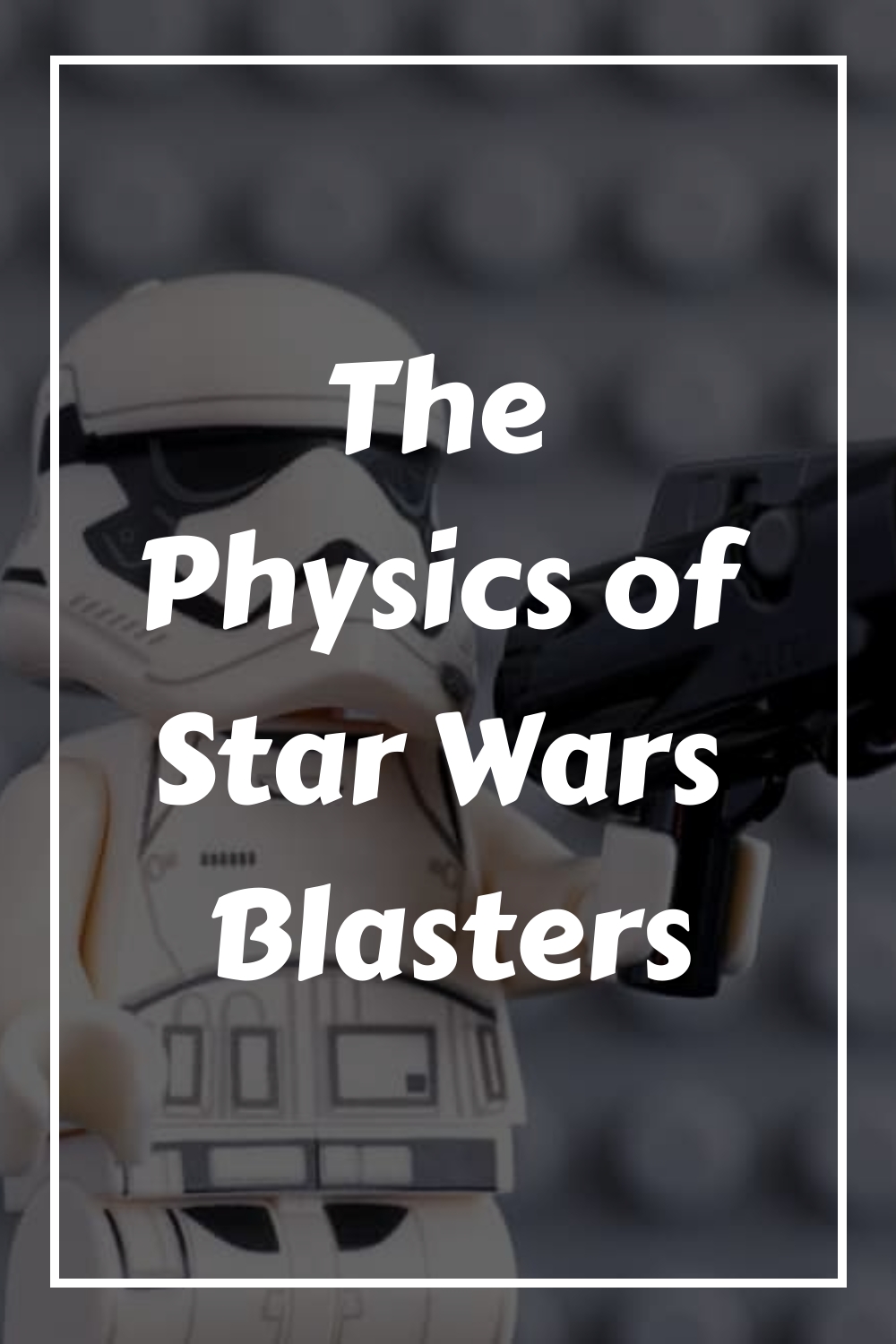Everyone has heard of Star Wars at some point of time in their lives. If they say they haven’t, they are either lying or were locked in an Imperial dungeon for an unknown amount of years. Who knows? It could be possible. Jabba the Hutt kept Han Solo locked in a state of suspended animation after all. With the technology in Star Wars, anything is possible. Even firing plasma beams out of pistols.
How do the blasters in Star Wars work? The blasters of Star Wars are powered by a compressed substance, Tibanna Gas, a substance that is found and mined in Cloud City. Once the Tibanna Gas is compressed, it becomes energized and is expelled from the barrel of the blaster weapon in use towards its target.
In the universe of Star Wars, while the physics are as realistic as possible; unfortunately, some of the technology is currently out of our grasp because our current capabilities are not what they were in the time “that was so long, long ago.” Keep reading and learn for yourself the physics behind the blasters of Star Wars and the reality of the technology.
What are Blasters in Star Wars and How do They Work?
In Star Wars, the blasters are the pistols and rifles that are typically carried by those who are not able to manipulate the energy known within the series as ‘The Force.’ They are utilized as a means of attack and defense by Imperial stormtroopers, droids, the Rebel Alliance, bounty hunters, and smugglers alike.
Blasters can be referred to as plasma weapons and laser weapons depending on the individual who is speaking, but it should be noted that the often interchanged names actually refer to different classes of blaster-style weapons. Here, we’re actually going to explain the difference between plasma weapons and laser weapons and look at what it would take for them to actually work.
How do Plasma Blasters Work?
If the blaster being examined in question is a plasma blaster, it is important to note that this blaster will function differently than your laser weapon would. Assuming that the weapon fires plasma bolts, it is going to rely upon a substance known as Tibanna Gas that is typically found in the location of Cloud City within Star Wars.
Now, Tibanna Gas does is not fireable in its gaseous form. A certain chain of events has to occur for the gas to become weaponized and have the capability to be converted into ammunition that is suitable to be fired from the plasma weapon as a bolt towards the intended target. If we look at it from the perspective of real-life gases, here is what needs to take place in order for it to be functional:
|
Star Wars
| Read Star Wars Science Fact |
|
First, we need to be able to
identify the appropriate temperature necessary for Tibanna Gas to
undergo conversion from a gas into a plasma. The temperature
required for a gas (hydrogen for this example) sits at the least a
few tens of thousands of degrees; however, it is not uncommon to
see it at hundreds of thousands or millions of degrees.
| Plasma is still a gas, albeit a different one. Normal gases are electrically neutral, but in plasma, electrons are either gained or lost. This means that the atoms and molecules of the plasma are either positively or negatively charged. These are known as Ions. |
|
Next, after the gas has been
converted into an extremely hot plasma gas, it needs to be
compressed in order to used as ammunition for the plasma blaster.
Since plasma is still a gas, there are certain rules that we can
assume still apply where compression of gases is concerned.
|
When gases, including plasma, are
compressed, the temperature of the compressed gas will rise even
higher than when the gas converted into plasma. Due to the
intensely high heat, the container in which the compressed plasma
is contained in needed to be able to withstand those high
temperatures and not melt when it comes into contact with the
plasma.
|
|
Finally, assuming that the blaster
is able to contain the compressed plasma and it is not going to
melt or explode upon firing, we have another factor to consider.
The accuracy of the plasma weapon. If you notice, the feared
Imperial Storm Troopers and Rebel Alliance alike don’t have the
best accuracy. Let’s examine how the weapon firing plasma bolts
affects their aim.
|
Plasma is affected by
electromagnetic fields. This is due to the plasma charge
particles. It only takes a magnetic field that is a million times
weaker than that of earth’s magnetic field to alter the course
of a plasma bolt. This would explain the terrible accuracy of the
blaster weapons fired by the Imperial Army and Rebel Alliance.
|
Another factor to take into account, outside of the accuracy of the plasma-based blaster, is the amount of damage it would do if it actually hit its intended target. Plasma, as we pointed out, is unbelievably hot. A human is not going to take a hit from it and merely fall down.
At the temperature of compressed plasma, it will surely disintegrate whatever it touches upon firing. So hypothetically speaking, if this was current technology and a plasma bolt struck a person in, let’s say the arm, that arm will no longer exist, and the wound would be instantly cauterized. This is if the plasma bolt would actually hit its target, of course.
To learn more about plasma and what it takes to actually create it, take a look at this article detailing the science regarding the subject. It is a great read and even explains some to the current real-life applications of this unusual gaseous substance.
How do Laser Blasters Work?
Assuming that the blasters used in Star Wars are actually laser blasters, the physics behind using them is actually dramatically more simple and more plausible to be applied within our less technologically advanced modern time.
Actually, we are not too far from making laser-based weaponry a reality, either. We already use lasers in surgeries and science, so repurposing them for Star Wars purposes is not too far-fetched to believe. However, the Imperial Army and Rebel Alliance are going to need to do some explaining as to why their aim is so horrible if they use laser weapons instead of plasma ones. Let’s examine the physics of lasers.
Laser beams are created when the electrons that are found in the atoms of gases, crystals, or special glasses absorb energy from a source of electrical current and become “excited.” This excitement is the atoms moving around faster and bouncing around. This will increase the temperature of the light from this source.
Real Star Wars Science Fact: Laser is not just some cool name that someone thought up. Well, not exactly. The word that we have come to know as laser is actually an acronym for what actually creates the famous laser beam. L.A.S.E.R. actually stands for (Light Amplification by Stimulated Emission of Radiation.)
Assuming that the blasters used in Star Wars are laser blasters, we need to look at the damage that they inflict upon the individuals that they hit. The strongest laser that we typically see around today are classified as Class 4 lasers. These are above 500 milliwatts in strength and will cause severe burns and ignite flammables in seconds.
This is more in line with the damage that is done to Princess Leia in the Battle of Endor in the Return of the Jedi Star Wars film when she was shot by Storm Troopers next to Han Solo. If it were a plasma blaster, she would have lost the entire arm.
Real Star Wars Science Fact: If the blasters in Star Wars are laser blasters, the bolt that is fired at a target moves entirely too slow. Lasers are still light, and within a vacuum, light moves at a speed of 186,282 miles per second and there is nothing that can travel faster. Unless the laser is a steady beam instead of a bolt, we won’t see it hit a target, let alone be dodged.
With the evidence presented here, and the physics behind how these weapons actually work, it is safe to say that the blasters used in Star Wars are actually plasma blasters, especially with the mention of Tibanna Gas (a fictional Star Wars gas) as the power source behind the blaster weapons used so frequently in the Star Wars films.
If you want some more information on the physics behind the weapons of Star Wars, take a look at this article written by Georgetown University’s Introductory Physics Professor, Patrick Johnson, Ph.D. Not only do they examine blasters within the iconic series, but they also examine the physics behind the lightsaber, electro staff, and various other Star Wars weapons as well.
Do Star Wars Blasters Have Recoil?
Since we have broken down the physics involved with Star Wars blasters, which we can now confidently identify as plasma blasters, after our thorough breakdown and investigation, we can confidently approach the question as to whether or not the plasma blasters of Star Wars produce what is known as recoil. In case you do not know what recoil is, we’ll take a brief moment to examine it below.
What is Recoil?
According to physics, recoil is a backward movement that is usually the result of a force or an impact. When we look at things that we will encounter in real life like firearms, the recoil is what you feel and observe once a round is fired from a firearm. This is also known as the blowback or kickback and occurs in every weapon that is fired from pistols and revolvers to rifles and shotguns.
Real Star Wars Science Fact: Recoil is the product of one of the most important laws of physics, the conservation of momentum. In the simplest terms, the force that pushed out the bullet( or plasma bolt) through the barrel of the weapon also acts on the weapon fired, which causes the kickback. Over time, the momentum will lessen which is why Newton’s 3rd law doesn’t apply here.
Since we are discussing Star Wars and have broken down what it takes to fire a plasma weapon while explaining what recoil is, let’s take the evidence gathered to determine whether or not plasma blasters would actually generate recoil and take Hollywood movie logic out of the equation to get the real answer. Here are 2 important additional pieces of evidence we need to consider:
- The blasters are powered and fired using Tibanna Gas. Prior to acknowledging this, most people believed that it was a light-based weapon and didn’t realize that gas is what powered the weapon.
- If we look at the lasers that are used today, we do not experience recoil when using them, they are steady, allowing to use them for simple tasks such as pointing to things on a board to more complicated tasks such as cutting materials and performing surgeries, which recoil would make virtually impossible.
With these key pieces of evidence, the answer is clear. The plasma blasters of Star Wars do have recoil. If that was such a shock or hard to believe, let’s take a real-life example of a gas-based tool and translate it over to Star Wars. For this example, let’s look at something as simple as an air compressor.
When you turn on an air compressor, air is obviously going to come out of it, but have you ever paid attention to what else happens? Especially when the air compressor is stronger than your usual run of the mill ones but actually commercial grade? The answer is, it blows back. As air is being pushed out, there is a force that is also pushing the hose back.
Another example of this is visible with CO2 pistols. As the CO2 is released from the container, it is compressed in to expel a pellet or BB. There is also a blowback (recoil) that comes from that release of pressure. Since plasma is still a gas and is a compressed one in the blasters, it is safe to assume that the same principle applies to the blasters of Star Wars as well. Take a second to see it in action yourself.
Do Star Wars Blasters Have Ammo?
This is also a great question with the evidence that we gathered and establishing the Star Wars blasters as plasma-based weapons. Now, to answer this question, we cannot look at it as the tradition ammo count within a magazine since that’s not exactly how blasters function in Star Wars.
In order to provide you with a realistic answer that is not influenced by Hollywood logic yet again, we need to look at the plasma blasters themselves, yet again but we’re going to compare them to CO2 and compressed air canisters.
When we look at CO2 and compressed air canisters, we are typically informed by the manufacturer of how many uses we are going to get out of them, depending on what we are using them for. Even though these are both gases, that does not mean we are going to be able to use it without having to replace or refill them.
Since there are not actually traditional magazines with Star Wars plasma blasters, we have to assume that they work in a very similar fashion. They are powered by a superheated plasma, which is a gas and eventually will have to be replaced. It will also be dependent on how the plasma is used as well, which will determine how fast the canister will need to be replaced and how many shots are available as well.
With that being said, Star Wars blasters do require to be reloaded, just not in the conventional sense with an ammo count.
In Conclusion
In this iconic science fiction series, there is actually a lot of physics involved in how the blasters in Star Wars work. We investigated quite a bit, and though there are some contradictory factors such as the power of the now established plasma blasters and the speed of the bolts when they were called laser blasters in the original script, we managed to come to the best conclusion.
We even managed to explain the physics necessary to utilize both types of weapons, whether they were laser-based or plasma-based as well. We also concluded that due to being gas-based weapons that they are going to give off some recoil due to the force necessary to expel the plasma bolts from the weapon in question and that ammunition is required to function the weapon but not in the typical sense.
We hope that you found the information provided to you to be educational and informative and also boosted not only your Star Wars science fiction knowledge but your real scientific know as well. Also, if you want to learn more about Tibanna Gas, click the link provided to learn more about this gas and how it is converted into a destructive weapon.
Thanks for reading, and may the Force and real science be with you!






Leave a comment
You must be logged in to post a comment.